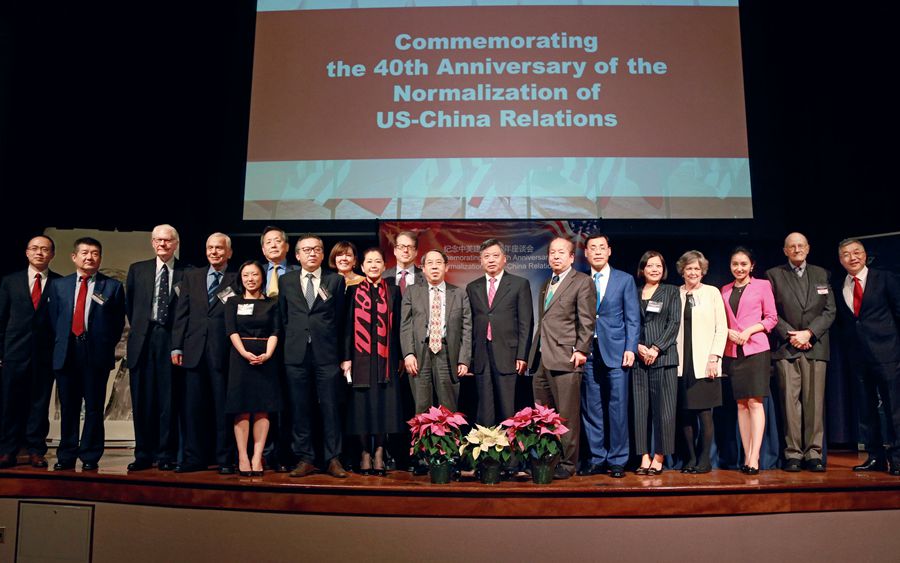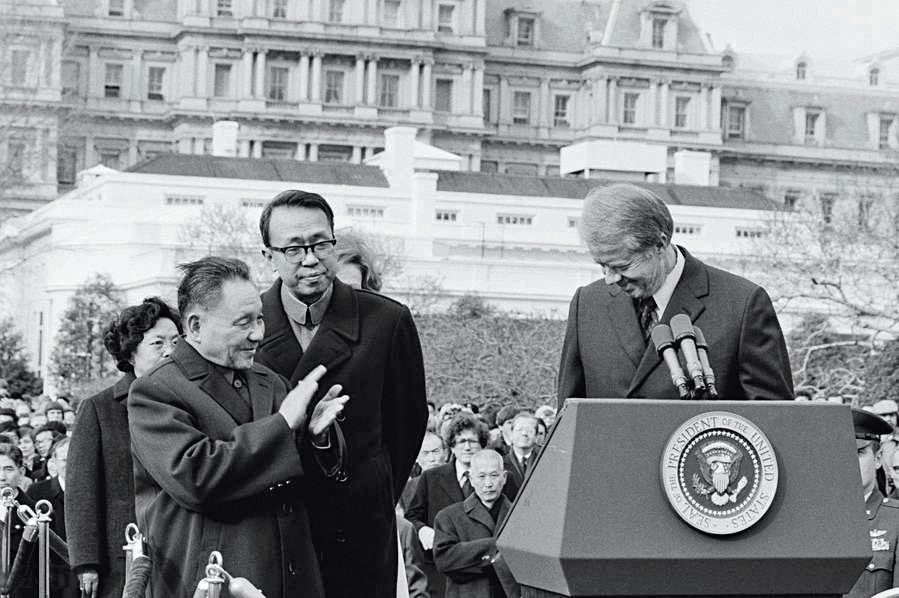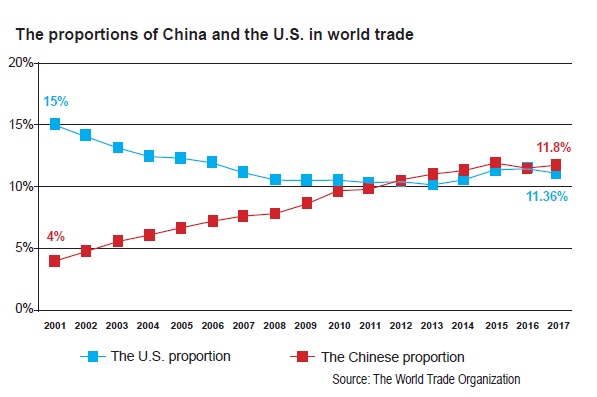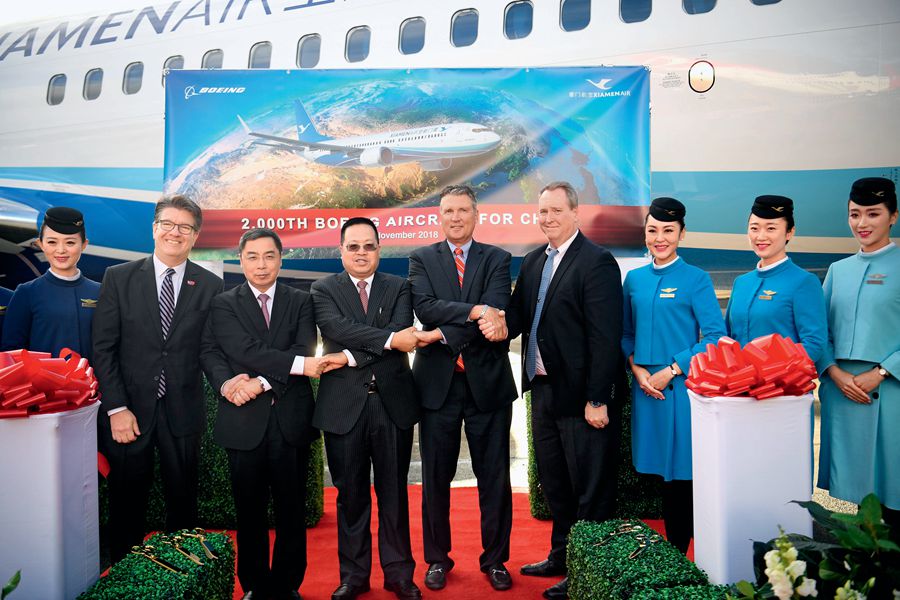IN January 2019, China and the United States heralded the 40th anniversary of the establishment of bilateral diplomatic relations. Over the four decades their relationship has undergone a bumpy journey, but in general has steadily moved forward.

The symposium marking the 40th anniversary of the normalization of U.S.-China relations is jointly held by the RUC North American Alumni Association and the Carter Center China Program in Atlanta, U.S., on December 15, 2018.
Compared with 40 years ago, many conditions have changed. Internationally, the world has shifted from the confronting bipolar system centering on the U.S. and the former Soviet Union to a multipolar one with American primacy. Global politics continuously advances toward multi-polarity. In terms of the world economy, a single world market has taken shape after the ending of two split political camps. Advances in technology further deepen globalization and shrink distances between countries.
As for China and the United States, their economic ties are getting increasingly closer. In 2017, bilateral trade in goods surpassed US $550 billion. They have maintained frequent high-level political exchanges, and the multiple dialogue mechanisms have strengthened political mutual trust.
However, the most significant change affecting China-U.S. relations is the change in the balance of power between the two countries. Particularly after China overtook Japan and emerged as the second largest economy in the world in 2010, the foundations of bilateral ties seemed to be challenged.

On January 29, 1979, Vice Premier Deng Xiaoping becomes the first Chinese leader to step foot on U.S. soil since the founding of the People’s Republic of China. U.S. President Jimmy Carter delivers a welcoming speech in front of the White House for the visiting Chinese Vice Premier Deng Xiaoping.
Whether both sides could properly judge each other’s strategic intentions and avoid misjudgment in this respect becomes the key to stabilizing and further advancing Sino-U.S. relations. The history of bilateral ties over the last 40 years offers inspiration on how to solve current frictions and disputes.
Sino-U.S. Relations against the Changing Balance of Power
In the past four decades, China’s economic and composite strengths have been dramatically enhanced. In 2010, China surpassed Japan and became the world’s second largest economy. It also overtook the United States in terms of the output of manufacturing and electric energy. At the end of 2015, China’s manufacturing output was 1.5 times that of the U.S. and was equal to the aggregate of the U.S. and Japan. In 2017, China’s GDP hit US $12 trillion, whereas the U.S. figure stood at US $19.3 trillion. Compared with 2010, China’s GDP rose by 98 percent, while the U.S. had its GDP grow by 30 percent.
In the 20th century, the U.S. had three rivals, which were Germany, Japan, and the former Soviet Union. At their peak, the three countries’ manufacturing capacities were merely two thirds that of the U.S. But China’s manufacturing power greatly shocked U.S. scholars and policy observers. The issues of how to cope with the changes in the balance of power between China and the U.S. and how to determine China’s strategic intentions have become the major concerns of U.S. strategists.

The U.S. began to adjust its strategy for China in the second term of the Obama administration. The policies of “Pivot to Asia” and rebalancing to Asia-Pacific were introduced to cope with the rising of China. The Obama administration aimed to counter the threat from the changes in the balance of power in the Asia-Pacific region by strengthening ties with its allies, increasing its military presence, and advancing the Indo-Pacific Strategy and Trans-Pacific Partnership.
After Donald Trump took office, the U.S. has been willing to work with China in addressing international issues, like forging stability in the Korean Peninsula, but has become more aggressive toward China. Against the backdrop of escalating Sino-U.S. trade frictions, the U.S. accusations against China are getting stronger and stronger.
As a result, many scholars tend to believe that the basis of U.S. policies toward China has changed, and that the Democrats and Republicans have reached a new consensus on the strategy for China, which is to choose containment, decoupling or confining strategies over the engagement strategy. Some even think that a conflict between China and the U.S. is inevitable, that the bilateral relations are slipping into the Thucydides Trap – when a rising power causes fear in an established power it escalates towards war – and that a new cold war between the two countries is on the verge of outbreak.
Whether China and the U.S. can escape the Thucydides Trap and avoid conflicts and confrontation depends, to a large extent, on whether the two sides are able to correctly judge each other’s strategic intentions and avoid strategic misjudgment.
China’s Strategic Intention Remains to Be Peaceful Development
Both China and the U.S. should have an accurate judgement on each other’s strategic intentions. The U.S. strategy for China is made based on the balance of power as well as China’s strategic intention. China remains committed to the path of peaceful development and advancing Sino-U.S. relations featuring no conflict or confrontation, mutual respect, and win-win cooperation. China has no intention to challenge the world order, but has been championing for it instead.

On November 30, 2018, guests attend Boeing’s delivery ceremony of its 2,000th aircraft to China, a Boeing 737 MAX for Xiamen Airlines, at the company’s delivery center in Seattle.
First, the international order, based on the United Nations (UN), is in line with the values and interests of China. After World War II, the UN has become the cornerstone of the global political order. The basic principles it built include respect for each country’s sovereignty and territorial integrity, mutual respect, mutual non-aggression, non-interference in each other’s internal affairs, equality and mutual benefits, and peaceful coexistence. These principles are what China has been championing in its diplomacy. As a permanent member of the UN Security Council, and a member of the Group 20, China is ready to work with other countries to maintain the stability of the international order.
Second, China’s economy has become more and more open over the last 40 years since the establishment of its diplomatic relations with the U.S. and China has emerged as an integral part of the world economy. China benefitted from the world economy and has been contributing toward its growth. In the next 30 years, China will remain a staunch supporter of free trade and multilateralism.
Third, China draws on historical experience and is well aware that seeking hegemony or confrontation only leads to the collapse of a great power. One of the most influential political events in the 20th century is the disintegration of the Soviet Union. Of course, there were various contributing factors. However, from the international perspective, the arms race and confrontation with the U.S. and its overseas expansion are crucial to the collapse of the great power. China is now at the critical stage of completing the building of a moderately prosperous society in all respects and striving for the second centenary goal of building China into a modern socialist country that is prosperous, strong, democratic, culturally advanced, and harmonious by the time the People’s Republic of China celebrates its centenary. China will not take the path of confrontation with the U.S. nor seek overseas expansion.
Determining Strategic Intentions
Over the past four decades, China-U.S. relations have undergone ups and downs, but in general have moved steadily forward. Both countries have accumulated some experience in exchanges with each other, which is helpful in determining each other’s strategic intentions.
First, high-level exchanges have spearheaded efforts in forging political mutual trust. In the past 40 years, the frequent contacts and visits of heads of state have become major ways for the two sides to establish strategical mutual trust. After the two countries established diplomatic relations on January 1, 1979, Deng Xiaoping paid a nine-day state visit to the U.S. from January 28 to February 5 of that year. The tour greatly promoted bilateral trade and changed the world order. Chinese President Xi Jinping and his counterparts former U.S. President Barack Obama and incumbent President Donald Trump have met on a frequent basis to discuss major issues affecting bilateral relations. For example, Xi and Trump raised a raft of constructive proposals to properly address differences and problems between the two countries, so as to bring bilateral relations back on track at their meeting during the recent G20 summit in Argentina.
Second, the two sides should give full play to bilateral dialogue mechanisms. The two countries attempted to establish a high-level dialogue mechanism as early as the administration of George W. Bush. In 2005, China and the U.S. announced an official high-level dialogue mechanism for regular exchanges on political and economic issues. In August that year, the two countries held the first strategic dialogue. Another five rounds were held from 2006 to 2008. The U.S. representative, Henry Paulson, said that the dialogue helped build mutual trust among officials of the two countries and was helpful to solve specific issues.
During the Obama administration in 2009, China and the U.S. agreed to establish the China-U.S. Strategic and Economic Dialogue mechanism. A total of eight rounds of dialogue were held from 2009 to 2016. They focused on economic and strategic issues.
In April 2017 when Xi met Trump, they announced the establishment of four high-level mechanisms of dialogue on diplomacy and security, comprehensive economic dialogue, dialogue on law enforcement and cyber security, and dialogue on social and cultural issues. These mechanisms played an important role in solving specific issues and determining the other’s strategic intentions. Under current circumstances, the two sides should give better play to these mechanisms.
Third, the two sides should further mutually beneficial economic partnerships. Economic ties have long been regarded as the bedrock of bilateral relations. Although some scholars began to express concerns over the economic interaction between the two countries due to escalating trade frictions, and even to see economic connections as the new sources of stability, economic interdependence still plays a positive role in maintaining stable relations between China and the U.S.
The past 40 years have shown that both China and the U.S. benefitted from closer economic ties. China is the largest trading partner of the U.S., and the U.S. is the second largest trading partner of China. Since its inclusion in the World Trade Organization, China’s imports from the U.S. have increased by 500 percent and China has consistently been the biggest overseas market for many American products. The U.S. exports 62 percent of its soybeans, 14 percent of cotton, 17 percent of vehicles, 15 percent of integrated circuits, and 25 percent of the global deliveries of Boeing aircraft to China. In essence, bilateral trade is beneficial to both countries. Meanwhile, as bilateral economic ties become closer, the forces inside both countries that work for the friendly relations of China and the U.S. are becoming stronger.
Today, the world is undergoing unprecedentedly profound changes. Whether China-U.S. relations can steadily move forward depends largely on the judgement of each other’s strategic intentions. China’s commitment to the path of peaceful development is steadfast. No matter how the balance of power changes, China will remain a staunch supporter of and contributor to world order.
QU BO is director of the Institute of International Relations at China Foreign Affairs University.



